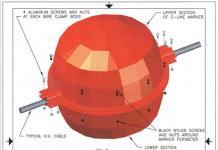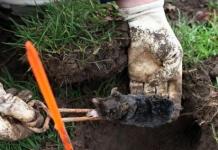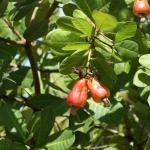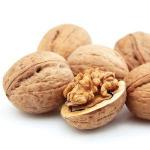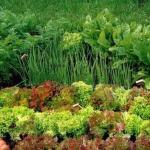Many people disparage wormwood, calling it a nasty weed. But I consider her my protector from many misfortunes - pests and diseases of the garden and vegetable garden, and even from human diseases. Over the years I have gained experience in its use.
Previously, I harvested wormwood on the side of country roads, but I inadvertently brought the seeds to my plot, where the plant began to grow and multiply, so that I no longer need to go anywhere specially to get it. And I'm not trying to get rid of it. I have islands of wormwood under almost every young apple and pear tree, near fences and outbuildings, where they don’t bother anyone at all.
However, do not think that it is growing uncontrollably. The needs for wormwood and its reproduction are balanced so that it does not have to stay in the ground. I extract plants in whole or in part at a young or adult age - with my hands or with a trident.
Wormwood also helps in the fall
The greatest need for wormwood occurs in the fall. Where it is not yet growing in the trunk circles of young apple and pear trees, I lay out the grass around the trunks. This protects trees from mice.
I tie a pair of long branches of wormwood to the trunks of young apple and pear trees on the south side using electrical tape. This is protection, on the one hand, from hares in winter, and on the other, from the heat of the sun's rays in early spring. Moreover, during the entire period of application of such protection, there were no cases of damage.
In places where mice may be infested (in a house, barn, cellar), I lay out wormwood branches. I do this in advance, since rodents are moving closer to housing in the winter. And although they sometimes settle in “forbidden” territories, the persistent smell of wormwood irritates the animals, and they leave.
When laying the foundation of the house, I also wrap wormwood branches in foam plugs.
Moths often appear in places where food and clothing are stored. To scare it away, I make special bundles with wormwood from pieces of old sheets.
Spring uses of wormwood in the garden
In the spring I remove wormwood from tree trunks, and also collect it from all the places where I spread it in the fall. But it’s too early to throw away the grass: it will serve until a new one grows.
What am I doing?
I spread out a decent piece of plastic film, place a wooden block in the center and begin chopping the collected wormwood with an ax. The flying pieces remain on the film. I pour the collected chaff into a 20-liter bucket, close it with a lid and place it in the sun. After 1-1.5 weeks (depending on the weather), I pour the infusion through a fine sieve into 6-liter plastic bottles.
By the way, I do the same with the husks and stalks of garlic and onions collected in the fall. I put the infusions in a cool, shaded place.
I use these infusions to combat late blight, alternating them and adding 1 tbsp for every 10 liters. l. potassium chloride, liquid soap and 1 g of potassium permanganate. This remedy also helps against powdery mildew, scab, and other fungal diseases.
I also use them to control pests - caterpillars, aphids, and other insects. I often add iodine, brilliant green, table salt, boric acid, and mullein to these infusions.
Not all plants are as harmless as wormwood. During the period of ripening and harvesting of fruits and vegetables, you should not spray plants with infusions of milkweed, tobacco, henbane, hemlock, celandine, and horse sorrel. They are poisonous to plants!
And in the garden it takes a lot of our time and energy. Quinoa, wheatgrass, knotweed, wormwood, acorn grass - these are not all the representatives of the flora that “voluntarily” settle on plots and interfere with full growth and development. How to get rid of grass on a plot? Summer residents are looking for the answer to this question from year to year. Effective methods of killing weeds, tested and approved by experienced gardeners, are presented in this article.
High-quality land cultivation
You can get rid of grass on your site as a result of seasonal work. In spring and autumn, when digging up the soil, use a pitchfork. With this tool, you can remove the grass completely from the ground without cutting its root, as often happens when working with a shovel. If a particle of weed remains in the ground, it is possible that it will grow again in this place next year.
As soon as the first grass has sprouted on the site in the spring, it must immediately be pulled out by the roots. If the soil is wet, it is better to pull it out with your hands. To ensure that the grass does not take root again on the surface of the soil, it is necessary to carefully select it and move it outside the site.
How to remove grass from a site: natural methods
When working on the site, we, without thinking about it, use traditional methods of weed control.

Herbicides are the “heavy artillery” in the fight against weeds
When thinking about how to get rid of grass on a site, especially when it comes to perennial weeds (wheatgrass, sow thistle, nettle), many summer residents opt for the use of herbicides. These are systemic preparations based on glyphosate, the effect of which on plants leads to the death of the latter. Today, the most effective herbicides are Roundup, Zero, Hurricane, and Tornado. Before getting rid of grass on your property using these drugs, carefully read the instructions for their use. Spraying is carried out in dry and windless weather. The first results of the treatment can be seen within a week. During this time, the drug is absorbed into the plant cells, destroying them. The leaves begin to wither and dry out. After 20-25 days, the perennial dies entirely.

During the period of action of glyphosate group preparations, it is not recommended to influence the soil around the weeds in any way (weeding, digging, watering). This can disrupt the process of moving the herbicide through the plant cells and block its work. It is necessary to use Roundup and similar products before sowing vegetable seeds or after harvesting.
In order for your garden and vegetable garden to please you with a good harvest, it is important not only to know how to get rid of grass on your site, but also to be able to do it efficiently. Take into account the tips presented in this article, and already next season you will notice that there are significantly fewer weeds in your garden.
How to grow wormwood in the country
Wormwood is a perennial herbaceous essential oil plant that is widespread throughout Russia.
The straight branched stem of wormwood can reach a height of one or more meters. The short, pressed hairs of the plant give it a grayish-silver tint.
Small tubular flowers of wormwood are collected in small baskets with a diameter of no more than 3 mm, which are separated from the stem by very short branches, located next to each other they form the so-called “panicle”.
Wormwood begins to bloom in July. At the end of August - beginning of September, the seeds ripen. The brownish oblong seed fruits of wormwood do not exceed 1 mm in length.
Wormwood is propagated by cuttings, division (spring or autumn) or seeds are sown in open ground (spring).
At the dacha, it is better to plant wormwood in semi-shaded or open sunny areas. The plant is undemanding in terms of soil composition and care. At the end of the year it is necessary to prune. The distance between neighboring plants should be approximately 40 cm.
The collection is carried out at the time of budding of the plant - the beginning of flowering (July). The leaves of wormwood are torn off, the grass tips of the shoots (up to 25 cm from the top) are cut off with a knife.
Drying should be done outdoors in the shade or in special dryers at a temperature of +40 to +50 C.
Useful wormwood - application of its properties in the garden and in the garden
Useful wormwood: using its properties in the garden and in the garden
Many people disparage wormwood, calling it a nasty weed. But I consider her my protector from many misfortunes - pests and diseases of the garden and vegetable garden, and even from human diseases. Over the years I have gained experience in its use.
Previously, I harvested wormwood on the side of country roads, but I inadvertently brought the seeds to my plot, where the plant began to grow and multiply, so that I no longer need to go anywhere specially to get it. And I'm not trying to get rid of it. I have islands of wormwood under almost every young apple and pear tree, near fences and outbuildings, where they don’t bother anyone at all.
However, do not think that it is growing uncontrollably. The needs for wormwood and its reproduction are balanced so that it does not have to stay in the ground. I extract plants in whole or in part at a young or adult age - with my hands or with a trident.
Wormwood also helps in the fall
The greatest need for wormwood occurs in the fall. Where it is not yet growing in the trunk circles of young apple and pear trees, I lay out the grass around the trunks. This protects trees from mice.
I tie a pair of long branches of wormwood to the trunks of young apple and pear trees on the south side using electrical tape. This is protection, on the one hand, from hares in winter, and on the other, from the heat of the sun's rays in early spring. Moreover, during the entire period of application of such protection, there were no cases of damage.
In places where mice may be infested (in a house, barn, cellar), I lay out wormwood branches. I do this in advance, since rodents are moving closer to housing in the winter. And although they sometimes settle in “forbidden” territories, the persistent smell of wormwood irritates the animals, and they leave.
When laying the foundation of the house, I also wrap wormwood branches in foam plugs.
Moths often appear in places where food and clothing are stored. To scare it away, I make special bundles with wormwood from pieces of old sheets.
Spring uses of wormwood in the garden
In the spring I remove wormwood from tree trunks, and also collect it from all the places where I spread it in the fall. But it’s too early to throw away the grass: it will serve until a new one grows.
Read also: Wormwood - medicinal properties and uses
What am I doing?
I spread out a decent piece of plastic film, place a wooden block in the center and begin chopping the collected wormwood with an ax. The flying pieces remain on the film. I pour the collected chaff into a 20-liter bucket, close it with a lid and place it in the sun. After 1-1.5 weeks (depending on the weather), I pour the infusion through a fine sieve into 6-liter plastic bottles.
By the way, I do the same with the husks and stalks of garlic and onions collected in the fall. I put the infusions in a cool, shaded place.
I use these infusions to combat late blight, alternating them and adding 1 tbsp for every 10 liters. l. potassium chloride, liquid soap and 1 g of potassium permanganate. This remedy also helps against powdery mildew, scab, and other fungal diseases.
I also use them to control pests - caterpillars, aphids, and other insects. I often add iodine, brilliant green, table salt, boric acid, and mullein to these infusions.
Not all plants are as harmless as wormwood. During the period of ripening and harvesting of fruits and vegetables, you should not spray plants with infusions of milkweed, tobacco, henbane, hemlock, celandine, and horse sorrel. They are poisonous to plants!
Wormwood description, application, placement in the country
Wormwood: description, application, placement in the countryside In continuation of the material about wormwood, I propose today to talk about one more species - wormwood. It is possible that it was from this wormwood that the Egyptian priests of Isis, the goddess of fertility and motherhood, wore wreaths on their heads. The specific Latin name for wormwood is absinthium, translated from Greek, meaning without pleasure, because it has a very bitter taste.

Photo used from www. invasive org
Botanical certificate
Wormwood (Artemisia absinthium), like all wormwoods, is a representative of one of the largest families - the Asteraceae. This is a perennial herbaceous, densely pubescent and, therefore, grayish-silver plant with a characteristic odor and bitter taste; in warm areas, it is often a subshrub with an erect, branched stem, up to 1 m high. The leaves are dissected; meticulous botanists described them as twice or thrice pinnately dissected. The flowers are very small, yellow, collected in an inflorescence of a basket, forming one-sided, slightly drooping panicles; bloom in July-September. The fruits are achenes; ripen in August-October.
Decorative variety ‘Lambrook Silver’ (75 cm high, deeply dissected leaves, silvery).

Photo used from www. crowders. co. uk
Where is it found in nature?
It is found near roads, buildings, in gardens, ditches, in weedy places, wastelands in the European part, in the Caucasus, Western Siberia, and Central Asia.
How is wormwood used?
This is a wild spicy, medicinal, highly ornamental, insecticidal plant. The leaves are eaten (a bitter seasoning for meat dishes). For medicinal purposes, the herb is used to stimulate appetite, improve the functioning of the digestive tract, as a choleretic, diuretic, sedative, disinfectant, anti-inflammatory, anthelmintic, analgesic, and wound healing agent.
How to place wormwood in the country?
It is enough to have 1-2 plants on the site, which should be kept away from neighbors, as they inhibit their growth. Can be used for planting in a spicy bed or rock garden, where it will support a silvery color scheme that harmoniously fits into the stone landscape. The distance between plants is 40-60 cm. Prefers dry soils, undemanding to fertility.
Do you have wormwood growing in your dacha?
Quarantine organism
Family: Asteraceae, Compositae
Genus: Wormwood (Artemisia)
Biological classification
Definition
Wormwood- a weedy perennial plant. Height up to 120 cm. Taproot. The surface is covered with adjacent short felt hairs, giving the surface a grayish or silvery tint. The stem is branched, straight. The leaves are of various shapes: twice or thrice pinnately dissected, trifoliate, pinnate, entire or with small teeth. Yellow spherical baskets are collected in a common paniculate inflorescence. The fruit is an obovate, light brown achene. The weed is widespread in Eurasia, North America, and North Africa. (Shishkin B.K., 1961) (Trukhachev V.I., 2006) (Gubanov I.A., 2004)
Morphology
The shoots are densely covered with gray hairs. The subcotyledon part is thin, reddish. The epicotyledonous internode is either undeveloped or inconspicuous, but covered in dense hairs. Cotyledons are elliptical with a round apex, almost sessile. Cotyledon dimensions: 2.5 – 3 x 1.5 – 2 mm.
The first two leaves are pointed and oval. Size 3 – 7 x 1.5 – 3.5 mm. Petioles 2 – 3 mm.
The next two leaves (third, fourth) are opposite, wedge-shaped with sharp short-lanceolate teeth on the sides. The apex has a larger, rounded middle tooth, at the top of which there is a spine.
Subsequent leaves are round or short-ovate, pinnately divided. The lobes are lanceolate and directed upward. There is a spine at the top. (Vasilchenko I.T., 1965)
An adult plant is covered with dense, short-lying hairs, giving it a grayish or silver-felt tint. Height up to 120 cm. The straight, short-branched stem at the base sometimes forms shortened sterile shoots with long-petioled leaves, 6 – 9 x 3 – 7 cm in size. These leaves are broadly ovate, three times pinnately dissected. The terminal lobules are lanceolate, pointed. In the middle part of the stem, the leaf blades are located on short petioles without lobes at the base. They are doubly pinnately dissected. The upper leaves are sessile, simply pinnate or twice trifoliate. Bracts can be trifoliate or entire, narrowly lanceolate. (Shishkin B.K., 1961) (Trukhachev V.I., 2006)
Small yellow spherical baskets, up to 3.5 mm in diameter, are collected in a common paniculate inflorescence. The leaves of the involucre are oblong-oval, hairy with a wide film along the edge. The receptacle is hairy and convex. Marginal flowers are pistillate (25 pieces). Median – bisexual (60 pieces). (Shishkin B.K., 1961)
After flowering, obovate, often curved, light brown achenes are formed. Size 0.7 – 1 x 0.5 – 0.5 x 0.4 – 0.5 mm. Weight of 1000 pieces of achenes is 0.15 - 0.2 g (Dobrokhotov V.N., 1961) (Trukhachev V.I., 2006)
The underground part, represented by a thick taproot. (Shishkin B.K., 1961)
Biology
Wormwood- a perennial root shoot plant. It spreads equally well by seeds and rhizomes. Germination of seedlings and shoots with underground buds begins at a temperature of + 8°C. The optimal temperature for seedling formation is + 26°C - +28°C. Abundant formation of weed seedlings is observed from March to May and in autumn. Autumn seedlings overwinter.
Wormwood blooms in July - September, bears fruit in September - October. The maximum established fecundity is 926,700 achenes. Freshly ripened achenes have sufficient germination, but those buried deeper than 3 cm do not germinate. (Fisyunov, 1984)
Spreading
Habitat in nature
Wormwood lives within the forest and forest-steppe zones. Favorite habitats are weedy places, residential areas, roadsides, gardens, vegetable gardens, field edges. (Nikitin V.V., 1983)
Geographical distribution
Wormwood- a widespread plant. The range lies in Eurasia, North Africa and North America. In the Russian Federation it is distributed throughout the entire territory, including the Central Russian regions. (Gubanov I.A., 2004)
Maliciousness
Wormwood– a ruderal plant that infests vegetable and grain crops and perennial grasses. The species acts as a weed in the zone of broad-leaved and mixed (coniferous-deciduous) forests. Clogging of fields causes:
- excessive shading of plants and soil;
- drying out of the upper soil layers;
- increased nutrient removal;
- spread of diseases and pests;
- deterioration in the performance of soil cultivation and harvesting equipment. (Masterov A.S., 2014) (Vasilchenko I.T., 1965) (Dobrokhotov V.N., 1961) (Shlyakova E.V., 1982)
Subordinate unit pesticides against
Chemical pesticides:
Spraying during the growing season.


